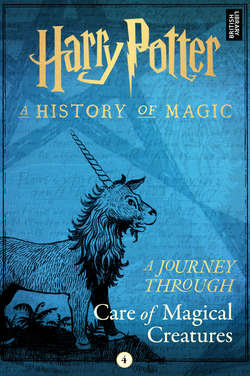Читать книгу A Journey Through Care of Magical Creatures - Pottermore Publishing - Страница 4
На сайте Литреса книга снята с продажи.
Part 1: Visions of the Unicorn
ОглавлениеThe unicorn is a beautiful beast found throughout the forests of northern Europe. It is a pure white, horned horse when fully grown, though the foals are initially golden and turn silver before achieving maturity.
Fantastic Beasts and Where to Find Them
Unicorns have been written about in natural history books and medical texts for thousands of years as though they might have been found out in the wild. Today, we have cute, cuddly toy unicorns that sneeze rainbows. The characteristics of unicorns have varied greatly down the years: there have been fierce unicorns, luck-bringing unicorns, unicorns as symbols of purity and unicorns whose body parts have magical medical properties.
They’ve lived in people’s imaginations through stories and myths, so much so that you might just be able to believe that these wondrous beasts roamed free in some far-off exotic land. But, if these gentle, elusive woodland creatures did exist, sadly there would probably be someone who’d want to hunt them.
The blood of a unicorn will keep you alive, even if you are an inch from death, but at a terrible price. You have slain something pure and defenceless to save yourself, and you will have but a half-life, a cursed life, from the moment the blood touches your lips.
Firenze – Harry Potter and the Philosopher’s Stone
In the Harry Potter series killing a unicorn is an awful thing to do, and historical traditions also underlined it as a very serious crime that resulted in sullying your soul. In the real world there are documented instances of apparent unicorn hunting. One of them appears in Ambroise Paré’s Discourse on the unicorn, published in 1582. Paré was chief surgeon to the French crown, an innovator and early adopter of evidence-based research. The book (despite its fantastical unicorns) was actually a text questioning the falsehoods in ancient medicine. His writing had been prompted by a patient asking a sceptical Paré to prescribe unicorn horn for some complaint – the image in his book showed the killing and skinning of a ‘pirassoipi’, or two-horned unicorn.
It was the unicorn all right, and it was dead. Harry had never seen anything so beautiful and sad. Its long, slender legs were stuck out at odd angles where it had fallen and its mane was spread pearly-white on the dark leaves.
Harry Potter and the Philosopher’s Stone
‘It’s not easy ter catch a unicorn, they’re powerful magic creatures. I never knew one ter be hurt before.’
Hagrid – Harry Potter and the Philosopher’s Stone
Unicorns also appeared in On the Properties of Animals, published in Paris in the 16th century. The book was a ‘bestiary’, a compendium of animals, written in Greek by a Cypriot scribe, and produced for a European audience. Bestiaries often combined animals that were real with animals that we now know to be mythical. Along with drawings and descriptions of creatures like the heron, the pelican, a wolf, a porcupine and a cuttlefish, this bestiary had a centaur with a pair of over-extended arms serving as its front legs!
The text accompanying the illustrations was a poem about the natural world composed by the Byzantine poet Manuel Philes, who lived at the turn of the 14th century. It was then copied out for the bestiary by a Cypriot called Angelos Vergekios two hundred years later, and illustrations were supplied by his daughter.
